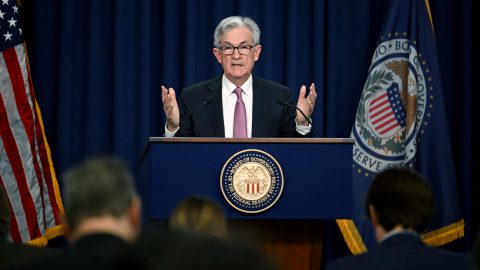As expected, the US central bank is accelerating the exit from ultra-expansive monetary policy. While key interest rates are being raised quickly and sharply, the central bank balance sheet is being reduced. Investors hope for a soft landing of the economy. Risks remain elevated.
On Wednesday, 4 May, the Fed raised the key interest rates, or more precisely: the range for the key interest rate by 0.5 percentage points to 0.75 – 1 percent. This is the first increase of this magnitude since 2000 and already the second rate hike in a row. In March, the Fed had initiated the interest rate turnaround with an increase of 0.25 percentage points. At the same time, the reduction for the central bank balance sheet was announced as of June: for government bonds, initially a maximum of 30 billion US dollars per month for three months, then a maximum of 60 billion US dollars per month. For mortgage bonds (agency MBS), the balance sheet can shrink by a maximum of 17.5 billion US dollars in the first three months, then by a maximum of 35 billion US dollars per month.
Further rate hike of 0.5 percentage points announced
At the press conference, Chairman Jerome Powell said that there was broad agreement in the committee that further hikes of 50 basis points (50 basis points = 0.5 percentage points) should be on the table at the next meetings. The measures did not come as a surprise to market participants. The Fed had already prepared the market for this in the past weeks with sharp statements on fighting inflation (hawkish stance) (forward guidance). The first market reaction was even relieved (yield declines in short-dated government bonds, price rises in equities) because a major interest rate hike of 0.75 percentage points was not considered. By the end of the year, a key interest rate of 2.81 per cent is priced into the market.
There are two reasons for the quick and rapid exit from loose monetary policy: the high inflation that has persisted for months and the low unemployment rate.
Highest inflation rate in decades
Inflation rates are very high. Not only the Fed has massively overestimated its inflation forecast. In March, consumer prices rose by 0.9 percent on a monthly basis and by 6.6 percent on an annual basis (PCE Deflator, source: US Commerce Department). A good part of this can be attributed to external shocks: Supply chain problems due to supply-demand imbalances driven by the indirect Corona effects and higher food and energy prices due to the war in Ukraine. Pretty much every country is showing the highest inflation rates in decades for this year. In the US, on top of that, the big fiscal packages have strongly supported consumer demand. The key question now is whether inflation expectations will remain permanently high or whether they will only be a temporary phenomenon.

Low rate of unemployment
In March, the unemployment rate fell to a very low level of 3.6 per cent. At the same time, wage growth has increased. In the first quarter, the labour cost index grew by 4.5 per cent year-on-year (source: Bureau of Labor Statistics). The relationship between the unemployment rate and wage growth described by the Phillips curve historically becomes stronger at low values of the unemployment rate. Moreover, inflationary pressures have widened on many inflation subcomponents. Thus, there are indications that GDP is above potential.
Uncertainty factor: output gap
In principle, there are three scenarios as to how the central banks will continue to act. The determining factor is the high uncertainty about the difference between actual gross domestic product (GDP) and potential (the output gap).
- If GDP is only moderately above potential, central banks (the Fed) can manage a soft landing of the economy in a favourable scenario. Long-term inflation expectations would remain low in this case. However, there are two unfavourable recession scenarios.
- If GDP is well above potential for an extended period of time, the probability of a switch to sustained high inflation expectations increases (overheating). The central bank is “behind the curve”. In this case, central bank policy would have to become very restrictive: That is, deliberately create a recession (high unemployment) to get inflation under control.
- The exit from expansionary monetary policy is too fast. Central banks react to external price shocks, cannot influence inflation rates in the short run, but affect the economy so much that a recession is triggered.
CONCLUSIONS
Our baseline scenario is a soft landing of the economy. However, the risks are heightened. In addition, it will be much harder for the Fed to react to a financial crisis with loose monetary policy in the future. At least as long as inflation remains high.
Explanations of technical terms on investment and securities can be found in our Fund Glossary: Fund Glossary (erste-am.at)
Legal note:
Prognoses are no reliable indicator for future performance.
Legal disclaimer
This document is an advertisement. Unless indicated otherwise, source: Erste Asset Management GmbH. The language of communication of the sales offices is German and the languages of communication of the Management Company also include English.
The prospectus for UCITS funds (including any amendments) is prepared and published in accordance with the provisions of the InvFG 2011 as amended. Information for Investors pursuant to § 21 AIFMG is prepared for the alternative investment funds (AIF) administered by Erste Asset Management GmbH pursuant to the provisions of the AIFMG in conjunction with the InvFG 2011.
The currently valid versions of the prospectus, the Information for Investors pursuant to § 21 AIFMG, and the key information document can be found on the website www.erste-am.com under “Mandatory publications” and can be obtained free of charge by interested investors at the offices of the Management Company and at the offices of the depositary bank. The exact date of the most recent publication of the prospectus, the languages in which the fund prospectus or the Information for Investors pursuant to Art 21 AIFMG and the key information document are available, and any other locations where the documents can be obtained are indicated on the website www.erste-am.com. A summary of the investor rights is available in German and English on the website www.erste-am.com/investor-rights and can also be obtained from the Management Company.
The Management Company can decide to suspend the provisions it has taken for the sale of unit certificates in other countries in accordance with the regulatory requirements.
Note: You are about to purchase a product that may be difficult to understand. We recommend that you read the indicated fund documents before making an investment decision. In addition to the locations listed above, you can obtain these documents free of charge at the offices of the referring Sparkassen bank and the offices of Erste Bank der oesterreichischen Sparkassen AG. You can also access these documents electronically at www.erste-am.com.
Our analyses and conclusions are general in nature and do not take into account the individual characteristics of our investors in terms of earnings, taxation, experience and knowledge, investment objective, financial position, capacity for loss, and risk tolerance. Past performance is not a reliable indicator of the future performance of a fund.
Please note: Investments in securities entail risks in addition to the opportunities presented here. The value of units and their earnings can rise and fall. Changes in exchange rates can also have a positive or negative effect on the value of an investment. For this reason, you may receive less than your originally invested amount when you redeem your units. Persons who are interested in purchasing units in investment funds are advised to read the current fund prospectus(es) and the Information for Investors pursuant to § 21 AIFMG, especially the risk notices they contain, before making an investment decision. If the fund currency is different than the investor’s home currency, changes in the relevant exchange rate can positively or negatively influence the value of the investment and the amount of the costs associated with the fund in the home currency.
We are not permitted to directly or indirectly offer, sell, transfer, or deliver this financial product to natural or legal persons whose place of residence or domicile is located in a country where this is legally prohibited. In this case, we may not provide any product information, either.
Please consult the corresponding information in the fund prospectus and the Information for Investors pursuant to § 21 AIFMG for restrictions on the sale of the fund to American or Russian citizens.
It is expressly noted that this communication does not provide any investment recommendations, but only expresses our current market assessment. Thus, this communication is not a substitute for investment advice.
This document does not represent a sales activity of the Management Company and therefore may not be construed as an offer for the purchase or sale of financial or investment instruments.
Erste Asset Management GmbH is affiliated with the Erste Bank and austrian Sparkassen banks.
Please also read the “Information about us and our securities services” published by your bank.


